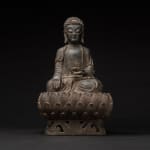Ming/Qing Bronze Seated Buddha, 15th Century CE - 18th Century CE
Bronze
44.5 x 27.9 cm
17 1/2 x 11 in
17 1/2 x 11 in
HK.2047
Further images
This is a bronze sculpture of the Buddha Shakyamuni from Ming/Qing Dynasty. Unlike the typical form at the time, this Buddha is depicted with his ushnisha right above his forehead....
This is a bronze sculpture of the Buddha Shakyamuni from Ming/Qing Dynasty. Unlike the typical form at the time, this Buddha is depicted with his ushnisha right above his forehead. Seated in Vajrasana posture, his hands perform the Bhumisparsa mudra, in which his right hand touches the ground and his left laid on his lap. His right chest is visible, while the sanghati is tied and held on his waist.
In principle, the Bhumisparsa mudra is a gesture reserved for the Buddha Shakyamuni. According to the life story of the Buddha, the demon Mara questions the Buddha’s enlightenment, saying that nobody was there to witness the process. The Buddha, with his right hand touching the ground, proclaims that the Earth stands witness to his enlightenment, and defeats Mara in the process.
The details on the lotus pedestal provides some hints for dating. The use of realistic and detailed lotus petals and the carved out base below the pedestal are prominent features of Ming dynasty casting style.
In principle, the Bhumisparsa mudra is a gesture reserved for the Buddha Shakyamuni. According to the life story of the Buddha, the demon Mara questions the Buddha’s enlightenment, saying that nobody was there to witness the process. The Buddha, with his right hand touching the ground, proclaims that the Earth stands witness to his enlightenment, and defeats Mara in the process.
The details on the lotus pedestal provides some hints for dating. The use of realistic and detailed lotus petals and the carved out base below the pedestal are prominent features of Ming dynasty casting style.







